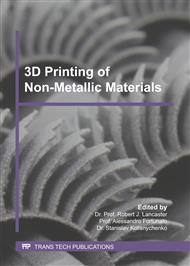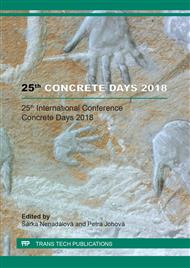[1]
M. Popescu, L. Reiter, A. Liew, T. Van Mele, R.J. Flatt, P. Block, Building in concrete with a knitted stay-in-place formwork: Prototype of a concrete shell bridge,Structures,14, (2018). 322-332.
DOI: 10.1016/j.istruc.2018.03.001
Google Scholar
[2]
Information on https://research.gsd.harvard.edu/maps/portfolio/2018-cevisama.
Google Scholar
[3]
T. Van Dousselaere and S. Van Geeteruyen, Exoskeleton: An emperical investigation into a bottom-up approach to structural design,, Disertation Thesis, Gent, (2017).
Google Scholar
[4]
M. Rippmann, T. van Mele, M. Popescu, E. Augustynowicz, T. Méndez Echenagucia, C. Calvo Barentin, U. Frick, and P. Block, The Armadillo Vault: Computational design and digital fabrication of a freeform stone shell,, in Advances in Architectural Geometry 2016, (2016), 344-363.
DOI: 10.3218/3778-4_23
Google Scholar
[5]
F. Xu, VULCAN: Closing the Loop in 3D-Printed Architectural Design,, Architectural Design, vol. 86, no. 5, (2016), 82-91.
DOI: 10.1002/ad.2093
Google Scholar
[6]
S. Lim, R. A. Buswell, P. J. Valentine, D. Piker, S. A. Austin, and X. De Kestelier, Modelling curved-layered printing paths for fabricating large-scale construction components,, Additive Manufacturing, vol. 12, (2016), 216-230.
DOI: 10.1016/j.addma.2016.06.004
Google Scholar
[7]
C. B. Costanzi, 3D Printing Concrete onto Flexible Surfaces,, MSc. Thesis, Delft, (2016).
Google Scholar
[8]
A. R. Ponce and R. R. Meléndez, Curves of Clay: Bóvedas del Bajío,, in Nexus V, Architecture and Mathematics., Florence: Kim Williams Books, 2004, pp.143-154.
Google Scholar
[9]
P. Block and M. Rippmann, The Catalan Vault: A Historical Structural Principle with a Bright Future,, DETAIL: Simple and Complex, 53(5), (2013), p.532,535-536.
Google Scholar
[10]
D. López López, M. Domènech Rodríguez, and M. Palumbo Fernández, "Brick-topia", the thin-tile vaulted pavilion,, Case Studies in Structural Engineering, 2, (2014), pp.33-40.
DOI: 10.1016/j.csse.2014.09.001
Google Scholar
[11]
Information on https://architizer.com/blog/practice/details/sameep-padora-maya-somaiya-library.
Google Scholar
[12]
T. Bock and T. Linner, Construction Robots: Elementary Technologies and Single-Task Construction Robots. Cambridge: Cambridge University Press, 2017, pp.65-78.
DOI: 10.1017/cbo9781139872041
Google Scholar
[13]
Information on: https://all3dp.com/1/3d-printing-support-structures.
Google Scholar
[14]
R. A. Buswell, W. R. Leal de Silva, S. Z. Jones, and J. Dirrenberger, 3D printing using concrete extrusion: A roadmap for research,, Cement and Concrete Research, 112, (2018), 37-49.
DOI: 10.1016/j.cemconres.2018.05.006
Google Scholar
[15]
B. Huang, Alternate Slicing and Deposition Strategies for Fused Deposition Modelling,, PhD. Thesis, Auckland, (2014).
Google Scholar
[16]
B. Khoshnevis, Automated construction by contour crafting—related robotics and information technologies,, in Automation in Construction, 13(1), (2004), 5-19.
DOI: 10.1016/j.autcon.2003.08.012
Google Scholar
[17]
Information on http://contourcrafting.com/wp-content/uploads/2017/07/Lunar-2.jpg.
Google Scholar
[18]
G. Cesaretti, E. Dini, X. De Kestelier, V. Colla, and L. Pambaguian, Building components for an outpost on the Lunar soil by means of a novel 3D printing technology,, Acta Astronautica, 93, (2014), 430-450.
DOI: 10.1016/j.actaastro.2013.07.034
Google Scholar
[19]
Information on https://inhabitat.com/worlds-largest-delta-style-3d-printer-can-print-nearly-zero-cost-housing-out-of-mud.
Google Scholar
[20]
Information on: https://www.ip.rwth-aachen.de/teaching/dynamo-tutorials.
Google Scholar
[21]
B. Khoshnevis, X. Yuan, B. Zahiri, J. Zhang, and B. Xia, Construction by Contour Crafting using sulfur concrete with planetary applications,, in Rapid Prototyping Journal, 22(5), (2016), 848-856.
DOI: 10.1108/rpj-11-2015-0165
Google Scholar
[22]
B. Khoshnevis, D. Hwang, K. T. Yao, and Z. Yeh, Mega-scale fabrication by Contour Crafting,, International Journal of Industrial and Systems Engineering, 1(3), (2006), 301–320.
DOI: 10.1504/ijise.2006.009791
Google Scholar
[23]
S. J. Keating, J. C. Leland, L. Cai, N. Oxman, Toward site-specific and self-sufficient robotic fabrication on architectural scales. Sci. Robot. 2(5), eaam8986, (2017).
DOI: 10.1126/scirobotics.aam8986
Google Scholar
[24]
F. Bos, R. Wolfs, Z. Ahmed, and T. Salet, Additive manufacturing of concrete in construction: potentials and challenges of 3D concrete printing,, Virtual and Physical Prototyping, 11(3), (2016) 209-225.
DOI: 10.1080/17452759.2016.1209867
Google Scholar
[25]
C. Gosselin, R. Duballet, P. Roux, N. Gaudillière, J. Dirrenberger, and P. Morel, Large-scale 3D printing of ultra-high performance concrete – a new processing route for architects and builders,, Materials & Design, 100, (2016), 102-109.
DOI: 10.1016/j.matdes.2016.03.097
Google Scholar
[26]
EN 1992-1-1:2004. Eurocode 2: Design of concrete structures – Part 1-1: General rules and rules for buildings (2011). ( 2). Czech Office for Standards, Metrology and Testing, Prague, (2011).
Google Scholar
[27]
F. Bos, Z. Ahmed, E. Jutinov, and T. Salet, Experimental Exploration of Metal Cable as Reinforcement in 3D Printed Concrete,, Materials, 10(11), (2017).
DOI: 10.3390/ma10111314
Google Scholar



